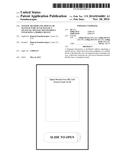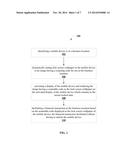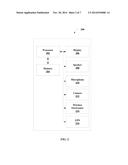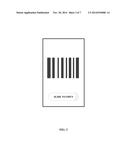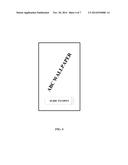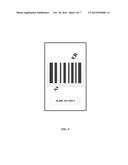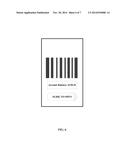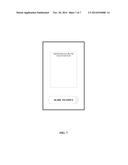Patent application title: System, Method and Article of Manufacture to Facilitate a Financial Transaction Without Unlocking a Mobile Device
Inventors:
Ramraj Soundararajan (Lorton, VA, US)
IPC8 Class: AG06Q2032FI
USPC Class:
705 16
Class name: Data processing: financial, business practice, management, or cost/price determination automated electrical financial or business practice or management arrangement including point of sale terminal or electronic cash register
Publication date: 2014-11-20
Patent application number: 20140344081
Abstract:
A financial transaction is facilitated without unlocking a mobile device,
where the lock screen wallpaper of a mobile device is dynamically set to
an image having a scanning code (e.g., a QR code, a barcode, etc.) for
use at a business location that the user is currently located.Claims:
1. A method to facilitate a financial transaction without unlocking a
mobile device comprising: identifying said mobile device is at a business
location; dynamically setting lock screen wallpaper in said mobile device
to an image having a scanning code for use at said business location;
activating a display of said mobile device and rendering said image
having a scannable code as said lock screen wallpaper on said activated
display of said mobile device which remains in said screen locked state;
and facilitating a financial transaction at said business location based
on said scannable code displayed as said lock screen wallpaper of said
mobile device, said financial transaction facilitated without having to
unlock said mobile device.
2. The method of claim 1, wherein said scannable code is a QR code.
3. The method of claim 1, wherein said scannable code is a barcode.
4. The method of claim 1, wherein said method further comprises reverting said lock screen wallpaper to a default lock screen wallpaper upon successful completion of said financial transaction.
5. The method of claim 1, wherein said financial transaction is associated with a financial account and said method further comprises updating said lock screen wallpaper to another image showing a balance left on said financial account after successful completion of said financial transaction.
6. The method of claim 1, wherein said method further comprises reverting said lock screen wallpaper to a default lock screen wallpaper upon leaving said business location.
7. The method of claim 1, wherein step of identifying said mobile device is at said business location is based on GPS data received at said mobile device.
8. The method of claim 1, wherein said step of identifying said mobile device is at said business location is based upon a near field communication (NFC) interaction with a device at said business location.
9. The method of claim 8, wherein said device at said business location is a NFC tag.
10. The method of claim 9, wherein said NFC tag is either integrated into a point-of-sale terminal or is attached to a point-of-sale terminal at said business location.
11. The method of claim 1, wherein said step of identifying said mobile device is at said business location is based upon a RFID interaction with a device at said business location.
12. The method of claim 11, wherein said device at said business location is a RFID tag.
13. The method of claim 12, wherein said RFID tag is either integrated into a point-of-sale terminal or is attached to a point-of-sale terminal at said business location.
14. The method of claim 1, wherein said step of identifying said mobile device is at said business location is based upon a Bluetooth interaction with a device at said business location.
15. The method of claim 14, wherein said device at said business location is a point-of-sale terminal.
16. The method of claim 1, wherein said scannable code comprises user defined customization data related to said financial transaction in addition to information required to perform said financial transaction.
17. The method of claim 1, wherein said financial transaction is a cloud-based transaction, wherein a payment provider automatically covers the cost of a purchase with issuer linked funds and, in a separate transaction, said payment provider charging the purchaser's selected, cloud-linked account in a card-not-present environment to recoup its losses on the first transaction.
18. The method of claim 1, wherein said mobile device is any of the following: a mobile phone, a tablet, a portable gaming device or a digital music player.
19. A mobile device comprising: a processor; a display; storage storing computer readable programmable code, which when executed by said processor implements a method to facilitate a financial transaction without unlocking a mobile device, said storage comprising computer readable program code to: identify said mobile device is at a business location; dynamically set lock screen wallpaper in said mobile device to an image having a scanning code for use at said business location; activate said display of said mobile device and render said image having a scannable code as said lock screen wallpaper on said activated display of said mobile device which remains in said screen locked state; facilitate a financial transaction at said business location based on said scannable code displayed as said lock screen wallpaper of said mobile device, said financial transaction facilitated without having to unlock said mobile device.
20. The mobile device of claim 1, wherein said mobile device is any of the following: a mobile phone, a tablet, a portable gaming device or a digital music player.
Description:
BACKGROUND OF THE INVENTION
[0001] 1. Field of Invention
[0002] The present invention relates generally to the field of mobile-based financial transactions. More specifically, the present invention is related to a system, method and article of manufacture to facilitate a financial transaction at a business location without unlocking a mobile device.
[0003] 2. Discussion of Related Art
[0004] It is well known in the art to utilize a mobile device, such as a cellular phone, to conduct financial transactions. As an example, a mobile device can be used to pay for financial transaction at a retail establishment. One such example is discussed below to note some of the problems associated with the prior art in conducting such financial transactions.
[0005] A retail establishment, e.g., ABC Coffee Shop, may have a software (may also be called an application or app) that a user is able to download on his/her mobile device. Once the software is downloaded and installed by the user of the mobile device, the user can then power up/open the mobile device, click on an icon representative of the software, and run the software on the mobile device, which may display, as part of the running software, a scannable barcode. Users are, therefore, able to use the software installed on the mobile device to conduct a transaction at the retail establishment, which in this example is the ABC Coffee Shop, by having someone at the retail establishment scan the barcode, which allows the user to purchase an item (or items) that he/she desires to buy.
[0006] A problem with this scenario is that the user has to go through numerous steps in order to access the software and pay for a purchase, which starts by unlocking the phone, finding the right page having the icon representative of the desired software, clicking on the icon for the desired software, navigating within the software to the appropriate location to load up the barcode that may be used for payment, and presenting the barcode to the retail establishment. This process is time consuming and is also error-prone.
[0007] This problem is further compounded for users with numerous software applications that are currently installed on their mobile device, which makes it even more difficult and time consuming to locate and run the software. One mechanism provided for in various mobile devices is the ability to search for a software among the list of installed software. But, even this approach requires the user to unlock the phone, type the first few characters of the software name (if the user can remember the name) and find an appropriate match in the results for the software corresponding to the retail establishment, i.e., the ABC Coffee Shop, run the software, and navigate within the software to the appropriate portion of the software that deals with conducting a transaction. This process is even more time consuming than the scenario discussed previously and is also error-prone.
[0008] Embodiments of the present invention are an improvement over prior art systems and methods.
SUMMARY OF THE INVENTION
[0009] The present invention provides for a method to facilitate a financial transaction without unlocking a mobile device, wherein the method comprises: identifying the mobile device is at a business location; dynamically setting lock screen wallpaper in the mobile device to an image having a scanning code (e.g., a QR code, a barcode, etc.) for use at the business location; activating a display of the mobile device and rendering the image having a scannable code as the lock screen wallpaper on the activated display of the mobile device which remains in the screen locked state; and facilitating a financial transaction at the business location based on the scannable code displayed as the lock screen wallpaper of the mobile device, the financial transaction facilitated without having to unlock the mobile device.
[0010] The present invention also provides for an article of manufacture having non-transitory computer readable storage medium comprising computer readable program code executable by a processor to implement a method to facilitate a financial transaction without unlocking a mobile device, the non-transitory computer readable storage medium comprising: computer readable program code identifying the mobile device is at a business location; computer readable program code dynamically setting lock screen wallpaper in the mobile device to an image having a scanning code (e.g., a QR code, a barcode, etc.) for use at the business location; computer readable program code activating a display of the mobile device and rendering the image having a scannable code as the lock screen wallpaper on the activated display of the mobile device which remains in the screen locked state; and computer readable program code facilitating a financial transaction at the business location based on the scannable code displayed as the lock screen wallpaper of the mobile device, the financial transaction facilitated without having to unlock the mobile device.
[0011] In one embodiment, the method further comprises reverting the lock screen wallpaper to a default lock screen wallpaper upon successful completion of the financial transaction.
[0012] In one embodiment, the financial transaction is associated with a financial account and the method further comprises updating the lock screen wallpaper to another image showing a balance left on the financial account after successful completion of the financial transaction.
[0013] In one embodiment, the method further comprises reverting the lock screen wallpaper to a default lock screen wallpaper upon leaving the business location.
[0014] In one embodiment, the step of identifying the mobile device is at the business location is based on GPS data received at the mobile device.
[0015] In one embodiment, the step of identifying the mobile device is at the business location is based upon a near field communication (NFC) interaction with a device at the business location. In an extended embodiment, the device at the business location is a NFC tag. In yet another extended embodiment, the NFC tag is either integrated into a point-of-sale terminal or is attached to a point-of-sale terminal at the business location.
[0016] In one embodiment, the step of identifying the mobile device is at the business location is based upon a RFID interaction with a device at the business location. In an extended embodiment, the device at the business location is a RFID tag. In yet another extended embodiment, the RFID tag is either integrated into a point-of-sale terminal or is attached to a point-of-sale terminal at the business location.
[0017] In one embodiment, the step of identifying the mobile device is at the business location is based upon a Bluetooth interaction with a device at the business location. In an extended embodiment, the device at the business location is a point-of-sale terminal.
[0018] In one embodiment, the scannable code comprises user-defined customization data related to the financial transaction in addition to information required to perform the financial transaction.
[0019] In one embodiment, the financial transaction is a cloud-based transaction, wherein a payment provider automatically covers the cost of a purchase with issuer linked funds and, in a separate transaction, the payment provider charging the purchaser's selected, cloud-linked account in a card-not-present environment to recoup its losses on the first transaction.
[0020] Non-limiting examples of the mobile device include any of the following: a mobile phone, a tablet, a portable gaming device or a digital music player.
[0021] The present invention also provides for a mobile device comprising: a processor; a display; and storage storing computer readable programmable code, which when executed by the processor implements a method to facilitate a financial transaction without unlocking a mobile device, the storage comprising computer readable program code to: identify the mobile device is at a business location; dynamically set lock screen wallpaper in the mobile device to an image having a scanning code for use at the business location; activate the display of the mobile device and render the image having a scannable code as the lock screen wallpaper on the activated display of the mobile device which remains in the screen locked state; and facilitate a financial transaction at the business location based on the scannable code displayed as the lock screen wallpaper of the mobile device, the financial transaction facilitated without having to unlock the mobile device.
BRIEF DESCRIPTION OF THE DRAWINGS
[0022] FIG. 1 illustrates an embodiment of the present invention to facilitate a financial transaction without unlocking a mobile device.
[0023] FIG. 2 depicts a non-limiting example of a mobile device according to the present invention.
[0024] FIG. 3 depicts an example of an image having the scannable code wherein the image is rendered as the lock screen wallpaper.
[0025] FIG. 4 depicts an example of a default lock screen wallpaper.
[0026] FIG. 5 depicts an example where the image having the scanning code is centered and partially covers the default lock screen wallpaper of FIG. 4.
[0027] FIG. 6 depicts an example of an image showing the scanning code and an account balance.
[0028] FIG. 7 depicts an example of a digital receipt shown as part of the lock screen background.
DESCRIPTION OF THE PREFERRED EMBODIMENTS
[0029] While this invention is illustrated and described in a preferred embodiment, the invention may be produced in many different configurations. There is depicted in the drawings, and will herein be described in detail, a preferred embodiment of the invention, with the understanding that the present disclosure is to be considered as an exemplification of the principles of the invention and the associated functional specifications for its construction and is not intended to limit the invention to the embodiment illustrated. Those skilled in the art will envision many other possible variations within the scope of the present invention.
[0030] FIG. 1 illustrates an embodiment of the present invention which discloses method 100 to facilitate a financial transaction without unlocking a mobile device. In step 102, the mobile device is identified to be at a business location. In one embodiment, the mobile device is identified as being located at the business location based on GPS data received at the mobile device. In another embodiment, the mobile device is identified as being located at the business location based upon a near field communication (NFC) interaction with a device at the business location. For example, the device at the business location may be a NFC tag and the mobile device may interact with such a NFC tag to confirm that it is located at a particular business location. In yet another extended embodiment, the NFC tag is either integrated into a point-of-sale terminal or is attached to a point-of-sale terminal at the business location.
[0031] In another embodiment, the mobile device is identified as being located at the business location based on a RFID interaction with a device at the business location. For example, the device at the business location may be a RFID tag and the mobile device may interact with such a RFID tag to confirm that it is located at a particular business location. In yet another extended embodiment, the RFID tag is either integrated into a point-of-sale terminal or is attached to a point-of-sale terminal at the business location.
[0032] In yet another embodiment the mobile device is identified as being located at the business location based on a Bluetooth interaction with a device at the business location. For example, the device at the business location may be a point-of-sale terminal that can communicate via Bluetooth with the mobile device.
[0033] In step 106, a processor in the mobile device dynamically sets a lock screen wallpaper in the mobile device to an image having a scanning code (e.g., a QR code, a barcode, etc.) for use at the business location the user is at. It is important to note that the lock screen wallpaper, which is displayed when the mobile device is in a locked state to conserve power, is updated, and not the home screen wallpaper, which is generally displayed when a mobile device is not in a locked state.
[0034] In step 108, a display of the mobile device is activated and the image having the scannable code is rendered as the lock screen wallpaper on the activated display of the mobile device which remains in the screen locked state. Such activation may be user initiated or triggered automatically (e.g., when the mobile device is proximate to a point of sale terminal). FIG. 3 depicts an example of such an image having the scannable code wherein the image is rendered as the lock screen wallpaper.
[0035] In step 110, a financial transaction is facilitated at the business location based on the scannable code displayed as the lock screen wallpaper of the mobile device, wherein such a financial transaction is facilitated without having to unlock the mobile device. For example, the attendant at the point of sale terminal may scan the scannable code displayed as the lock screen wallpaper of the mobile device and a financial transaction could be completed at the point of sale terminal for an item (or items) the user may wish to purchase at the business location.
[0036] In an alternative embodiment, the image having a scanning code (e.g., a QR code, a barcode, etc.) may be rendered in front of a default lock screen wallpaper (where it visually covers the entirety of the default lock screen wallpaper and looks like FIG. 3) or in front of a portion of the default lock screen wallpaper (see FIG. 4 for an example of a default lock screen wallpaper, and FIG. 5 for an example where the image having the scanning code is centered and partially covers the default lock screen wallpaper), where the default lock screen wallpaper is either a custom image previously set by the user of the mobile device or is the system default of the mobile device (the system default image for the lock screen wallpaper when the user has not previously set the lock screen wallpaper to a custom image). The point of sale terminal is able to scan the scannable code to complete a purchase at the business location.
[0037] In one embodiment, the method further comprises reverting the lock screen wallpaper to a default lock screen wallpaper (i.e., a lock screen wallpaper previously set by a user) upon either a successful completion of the financial transaction or upon the user leaving the premises of the business location.
[0038] In one embodiment, the financial transaction is associated with a financial account and the method further comprises updating the lock screen wallpaper to another image showing a balance left on the financial account after successful completion of the financial transaction. After displaying the image showing the balance as the lock screen wallpaper, the mobile device may revert to a default lock screen wallpaper (i.e., a lock screen wallpaper previously set by a user) upon either the expiration of a pre-determined time (e.g., a few seconds after the display of the image showing the balance) or upon the user leaving the premises of the business location.
[0039] In one embodiment, the image having a scanning code for use at the business additionally displays a balance associated with a financial account (e.g., an account associated with a credit card account, a gift card, a credit account associated with the business, etc.) which is used during the financial transaction. Such an example is shown in FIG. 6 which depicts the scanning code and the balance as part of the lock screen image.
[0040] In one embodiment, after successful completion of the financial transaction, the lock screen wallpaper is updated to display a digital receipt as new lock screen wallpaper. Such an example is shown in FIG. 7. The digital receipt image may be received from a device at the business location, like a point of sale terminal or may be received over a network such as the Internet or via the cellular network. After displaying the image showing the digital receipt as the lock screen wallpaper, the mobile device may revert to a default lock screen wallpaper (i.e., a lock screen wallpaper previously set by a user) upon either the expiration of another pre-determined time (e.g., a few seconds after the display of the image showing the digital receipt) or upon the user leaving the premises of the business location.
[0041] In one embodiment, the scannable code comprises user-defined customization data related to the financial transaction in addition to information required to perform the financial transaction. For example, the user may have previously stored data identifying order details associated with a drink (e.g., type of drink--coffee/espresso/cappuccino, syrup additives, number of pumps of syrup additives, type of milk to be used to make drink, etc.) or order details associated with a food item (type of toppings on a pizza, requested condiments, etc.) and this previously stored information regarding the order details may be encoded into the scannable code (at either the request of the user or is automatically identified via a profile storing what was previously ordered at the business location and is presented to the user for verification prior to being encoded as the scannable code), where the point of sale terminal may decode this information and the attendant at the point of sale terminal can review the order details. Such order details that may be encoded along with information required to perform a financial transaction may be useful in getting an order correct as it is directly from the user and is not based on the attendant at the point of sale terminal inputting such data, which by definition is error prone.
[0042] In one embodiment, the financial transaction is a cloud-based transaction, wherein a payment provider automatically covers the cost of a purchase with issuer linked funds and, in a separate transaction, the payment provider charging the purchaser's selected, cloud-linked account in a card-not-present environment to recoup its losses on the first transaction.
[0043] In one embodiment, the image having a scanning code for use at the business location is generated by a software running on the mobile device, wherein the software is associated with the business location.
[0044] Non-limiting examples of the mobile device include any of the following: a mobile phone, a tablet, a portable gaming device or a digital music player.
[0045] FIG. 2 depicts a non-limiting example of a mobile device 200 according to the present invention. While select components (processor 202 memory 204, display 206, speaker 208, microphone 210, camera 212, wireless electronics 214 required for wireless communication, GPS unit 216) are shown as being part of the mobile device 200, it should be noted that these components are provided as a simplistic case scenario and other known components (such as, but not limited to, a Bluetooth module, a NFC module, a RFID module), may be present within the mobile device 200. Mobile device 200 comprises: a processor 202; a display 206 (e.g. a touch screen display); and memory/storage 204 storing computer readable programmable code, which when executed by the processor implements a method to facilitate a financial transaction without unlocking a mobile device, the memory/storage 204 comprising computer readable program code to: identify the mobile device 200 is at a business location (using for example, GPS 216); dynamically set lock screen wallpaper in the mobile device 200 to an image having a scanning code for use at the business location; activate the display 206 of the mobile device 200 and render the image having a scannable code as the lock screen wallpaper on the activated display 206 of the mobile device 200 which remains in the screen locked state; and facilitate a financial transaction at the business location based on the scannable code displayed as the lock screen wallpaper of the mobile device 200, the financial transaction facilitated without having to unlock the mobile device 200. It should be noted that the mobile device may include any of the following: a mobile phone, a tablet, a portable gaming device or a digital music player.
[0046] Additionally, the present invention provides for an article of manufacture comprising computer readable program code contained within implementing one or more modules to facilitate a financial transaction without unlocking a mobile device. Furthermore, the present invention includes a computer program code-based product, which is a storage medium having program code stored therein which can be used to instruct a computer/processor to perform any of the methods associated with the present invention. The computer storage medium includes any of, but is not limited to, the following: CD-ROM, DVD, magnetic tape, optical disc, hard drive, floppy disk, ferroelectric memory, flash memory, ferromagnetic memory, optical storage, charge coupled devices, magnetic or optical cards, smart cards, EEPROM, EPROM, RAM, ROM, DRAM, SRAM, SDRAM, or any other appropriate static or dynamic memory or data storage devices.
[0047] The present invention also provides for an article of manufacture having non-transitory computer readable storage medium comprising computer readable program code executable by a processor to implement a method to facilitate a financial transaction without unlocking a mobile device, the non-transitory computer readable storage medium comprising: computer readable program code identifying the mobile device is at a business location; computer readable program code dynamically setting lock screen wallpaper in the mobile device to an image having a scanning code (e.g., a QR code, a barcode, etc.) for use at the business location; computer readable program code activating a display of the mobile device and rendering the image having a scannable code as the lock screen wallpaper on the activated display of the mobile device which remains in the screen locked state; and computer readable program code facilitating a financial transaction at the business location based on the scannable code displayed as the lock screen wallpaper of the mobile device, the financial transaction facilitated without having to unlock the mobile device.
CONCLUSION
[0048] A system, method and article of manufacture has been shown in the above embodiments for the effective implementation of facilitating a financial transaction without unlocking a mobile device. While various preferred embodiments have been shown and described, it will be understood that there is no intent to limit the invention by such disclosure, but rather, it is intended to cover all modifications falling within the spirit and scope of the invention, as defined in the appended claims. For example, the present invention should not be limited by software/program, computing environment, mobile environment, specific computing hardware, or specific mobile hardware.
User Contributions:
Comment about this patent or add new information about this topic:

